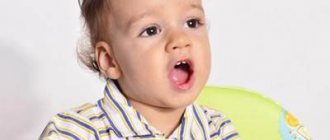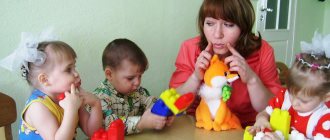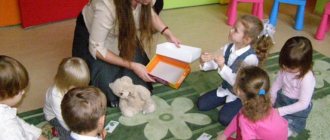General speech underdevelopment (GSD) is a severe speech disorder provided that hearing and intelligence are primarily intact. As a result, all structural components of speech are disrupted, namely: phonetics, phonemics, vocabulary, grammatical structure. OHP may be a separate disorder or result from other, more complex defects. The characteristics of children with general speech underdevelopment consist of psychological and pedagogical aspects.
For the first time, the features of speech development in children with general speech underdevelopment were outlined by R. E. Levina. She also suggested conditionally dividing ONR into three levels according to the severity of speech underdevelopment.
Psychological characteristics of OHP
Preschoolers with general speech underdevelopment are distinguished by a low level of development of the leading properties of attention. There is a weak stability of attention and the impossibility of its distribution. A speech defect has a negative effect on memory formation. Complex instructions are regularly forgotten, parts of instructions are omitted, and the sequence of execution changes. Repetitions are common when describing objects and images.
There is a lag behind peers in the development of visual-figurative thinking, problems with mastering the analytical-synthetic process and comparison. Such preschoolers have difficulties when learning according to the programs of general education institutions.
The characteristics of children with ODD also affect motor activity. They are characterized by impaired coordination of heavy movements, low speed and dexterity in a large number of preschoolers. They are bad at throwing the ball from one hand to the other, jump on one leg, and cannot dance to music based on the rhythm.
Fine motor skills are developed in a special way. This is noticeable when performing simple actions such as buttoning clothes or tying shoelaces.
Initially intact intellectual abilities are inhibited in their formation due to primary speech pathology. But in the process of correctional work, an adjustment and formation of thought processes occurs.
Article:
General underdevelopment of speech is considered as a systemic disorder of speech activity, complex speech disorders, in which the formation of all components of the speech system, relating to both the sound and semantic aspects, is impaired in children, with normal hearing and intact intelligence (R. E. Levina, T. B. Filicheva, G.V. Chirkina).
Speech failure with general speech underdevelopment in preschool children can vary from complete absence of speech to extensive speech with pronounced manifestations of lexico-grammatical and phonetic-phonemic underdevelopment (R. E. Levin). Currently, there are four levels of speech development, reflecting the state of all components of the language system in children with general speech underdevelopment (T. B. Filicheva).
At the first level of speech development, the child’s speech means are limited, the active vocabulary is practically not formed and consists of onomatopoeia, sound complexes, and babbling words. Statements are accompanied by gestures and facial expressions. Characteristic is the polysemy of the words used, when the same babbling words are used to designate different objects and phenomena. It is possible to replace the names of objects with the names of actions and vice versa. In active speech, root words without inflections predominate. The passive vocabulary is wider than the active one, but also extremely limited. There is practically no understanding of the categories of number of nouns and verbs, tense, gender, and case. The pronunciation of sounds is diffuse. Phonemic development is in its infancy. The ability to perceive and reproduce the syllabic structure of a word is limited.
When moving to the second level of speech development, the child’s speech activity increases. Active vocabulary expands due to everyday subject and verbal vocabulary. It is possible to use pronouns, conjunctions and sometimes simple prepositions. The child’s independent statements already contain simple, uncommon sentences. At the same time, there are gross errors in the use of grammatical structures, there is no agreement between adjectives and nouns, and there is a confusion of case forms. Understanding of addressed speech is developing significantly, although the passive vocabulary is limited, the subject and verbal vocabulary associated with the work activities of adults, flora and fauna has not been formed. There is a lack of knowledge not only of color shades, but also of primary colors.
Gross violations of the syllabic structure and sound filling of words are typical. Children exhibit insufficiency in the phonetic aspect of speech (a large number of unformed sounds).
The third level of speech development is characterized by the presence of extensive phrasal speech with elements of lexico-grammatical and phonetic-phonemic underdevelopment. There are attempts to use even sentences of complex constructions. The child's vocabulary includes all parts of speech. In this case, inaccurate use of the lexical meanings of words may be observed. The first word formation skills appear. The child forms nouns and adjectives with diminutive suffixes, verbs of motion with prefixes. Difficulties are noted in forming adjectives from nouns. Multiple agrammatisms are still noted. The child may use prepositions incorrectly and make mistakes in agreeing adjectives and numerals with nouns. Undifferentiated pronunciation of sounds is characteristic, and replacements may be unstable. Pronunciation deficiencies can be expressed in distortion, replacement or mixing of sounds. The pronunciation of words with a complex syllabic structure becomes more stable. A child can repeat three- and four-syllable words after an adult, but distorts them in the speech stream. Speech understanding is approaching normal, although there is insufficient understanding of the meanings of words expressed by prefixes and suffixes.
The fourth level of speech development (T. B. Filicheva) is characterized by minor violations of the components of the child’s language system. There is insufficient differentiation of sounds [t—t'—s—s'—ts], [p—p'—l—l'—j], etc. Characteristic are peculiar violations of the syllabic structure of words, manifested in the child’s inability to retain the phonemic image of a word in memory while understanding its meaning. The consequence of this is a distortion of the sound content of words in various versions. Insufficient speech intelligibility and unclear diction leave the impression of “blurry”. Errors in the use of suffixes (singularities, emotional connotations, diminutives) remain persistent. Difficulties in forming complex words are noted. In addition, the child experiences difficulties in planning a statement and selecting appropriate linguistic means, which determines the originality of his coherent speech. Complex sentences with different subordinate clauses present particular difficulty for this category of children. L.S. Volkova notes in children with general speech underdevelopment a persistent lag in the formation of all components of the language system: phonetics, vocabulary and grammar.
Speech activity is formed and functions in close connection with the child’s psyche (L.S. Vygotsky). Children with general speech underdevelopment have, in comparison with the age norm, features of the development of sensorimotor, higher mental functions, and mental activity.
R.M. Boskis, R.E. Levina, N.A. Nikashina note that in children with OPD, not only speech suffers, but also higher mental functions associated with it (attention, perception of various modalities, visual-spatial representations, optomotor coordination, memory and thinking), and fine motor skills of the fingers are insufficiently developed.
T.B. Filicheva also notes that while semantic and logical memory is relatively preserved, children’s verbal memory and memorization productivity are reduced compared to their normally speaking peers. Some preschoolers have low recall activity, which is combined with limited opportunities for the development of cognitive activity. The connection between speech disorders and other aspects of mental development determines some specific features of thinking. Having complete prerequisites for mastering mental operations accessible to their age, children lag behind in the development of the visual-figurative sphere of thinking, without special training they have difficulty mastering analysis, synthesis, and comparison. Many of them are characterized by rigidity of thinking. Such children experience difficulties in classifying objects and generalizing phenomena and signs.
Personality problems are also common in children with general speech underdevelopment: low self-esteem, communication disorders, anxiety, aggressiveness.
According to G.V. Chirkina, children have unstable and dwindling attention, poorly formed voluntary attention. It is difficult for children to concentrate on one subject and switch to another on a special task. Peculiarities in the course of mental operations are noted: along with the predominance of visual-figurative thinking, children may find it difficult to understand abstract concepts and relationships. The speed of mental operations may be somewhat slow.
R.E. Levina, G.A. Kashe, T. A. Tkachenko, S. N. Shakhovskaya, T. B. Filicheva, G. V. Chirkina, G. A. Volkova note that with OHP, phonetic disorders are common, have a persistent nature, and are similar in their manifestations to other articulatory disorders and pose significant difficulties for differential diagnosis and correction. These disorders have a negative impact on the formation and development of the phonemic aspect of speech.
E.F. Sobotovich, A.F. Chernopolskaya, L.V. Melekhova noted in children with OHP the inaccuracy, weakness of movements of the organs of the articulatory apparatus, their rapid exhaustion, and pronunciation deficiencies were eliminated only as a result of articulatory gymnastics and the development of the correct articulatory structure of a particular sound. Automation of sounds is extremely difficult.
In pedagogical terms, preschoolers with special needs G.V. Chirkina characterizes it as follows: “children’s behavior can be unstable, with frequent mood swings. During classes, children quickly get tired; it is difficult for them to complete one task for a long time. There may be difficulties in remembering the teacher’s instructions, especially two-, three-, four-step instructions that require step-by-step and sequential implementation.” These violations have a negative impact on the formation and development of other aspects of speech (phonemic, lexical, grammatical, coherent utterance).
T.B. Filicheva, N.A. Chevelev, deviations in the emotional-volitional sphere are noted in children with OHP. Children are characterized by instability of interests, decreased observation, decreased motivation, negativism, self-doubt, increased irritability, difficulties in communicating with others, in establishing contacts with their peers, difficulties in developing self-regulation and self-control.
Characteristics of speech in OHP level I
With level I OHP, most sounds are absent. Most often, the sounds of early ontogenesis remain undisturbed. Preserved sounds are unstable in use. In speech, the leading place is occupied by short words of one or two syllables. When trying to pronounce a longer word, the child skips syllables.
Children have difficulty distinguishing even non-speech sounds that are distant in sound. Both passive and active vocabulary are sharply limited. Kids mostly communicate non-verbally; they have well-developed facial expressions, gestures, and intonation.
When communicating verbally, onomatopoeic phrases are used, their fragments, words that are not similar to any others, “lightweight, childish”, used by one of the elders in conversations. The same word can be used to denote several concepts. The preschooler does not have phrasal speech or monologue. Level I OHP is diagnosed at the age of three.
Reasons for OHP
The causes that provoke ONR mainly relate to the period of pregnancy and childbirth, and the first years of the child’s life. They are the ones who cause severe forms of the disease.
Social reasons are no less important. This includes a lack of communication, living with deaf family members, lack of attention to the child in the family, and unfavorable conditions in which he lives and is raised.
How to treat this disease, what measures should be taken to restore speech function?
Characteristics of speech of children with ODD level II
Persons with degree II OHP have severe disturbances in sound pronunciation (up to 20 defective sounds). All types of its violations are characteristic: preschoolers replace sounds, distort them, mix them and skip them. They understand the meaning of the word, but cannot repeat the syllables in the correct sequence.
In two- and three-syllable words, children with level II OHP repeat the same sound or syllable (perseveration), rearrange them (paraphasia), replace the sound with the one following it (anticipation), mix fragments of several words (contamination), insert additional parts, reduce the number of syllables (elision). They do an excellent job of distinguishing non-speech sounds, but make mistakes when differentiating speech sounds that are distant in sound.
Children cannot master the basic basics of literacy. The passive vocabulary is scarce, the active vocabulary has many nominal parts of speech, there are adverbs and verbs. Inaccessible to them is word formation, which is replaced by inflection. Sentences are constructed from 2-4 words with the allowance of agrammatisms; coherent speech is usually replaced by a listing of events and objects. Stage II OHP is diagnosed after the age of four.
Definition of speech anomaly
ONR often occurs in the following syndromes: dysarthria, rhinolalia, alalia, aphasia. Based on this, 3 groups are distinguished:
- Uncomplicated forms of OCD (slight impairment of brain function is observed).
- Complicated forms of OPD (those with mental personality disorders or pathological changes in the development of the central nervous system).
- Severe speech pathology (when the functioning of the parts of the brain responsible for speech is disrupted).
When it becomes clear what form of anomaly the baby has, the level of speech skills is determined.
Characteristics of speech with OHP level III
With level III OHP, the range of problematic sounds is from 2 to 20. It is characterized by all types of sound pronunciation disorders. The syllable structure is distorted according to the same principle as at level II, but the use of words with a large number of syllables is problematic. Five-syllable words are difficult.
Children distinguish sounds that are distant in sound and pronunciation, but find it difficult to differentiate sounds that are close in parameters. Begin to become familiar with the processes of reading and writing. Children are left with a poor passive vocabulary. The active vocabulary is sufficient for everyday situations. There are multiple substitutions of words that are similar in meaning. Typically incorrect understanding and use of generalizing concepts.
Word formation becomes available. But when forming words, a preschooler makes many mistakes: he uses suffixes incorrectly, and chooses the wrong stem. A monologue is characterized by a small volume, omission of large parts, inversions, and violation of logical and temporal connections.
Errors in inflectional processes appear much less frequently. Level III OHP is diagnosed after 5 years.
Diagnostics
Diagnosis of OHP is made by a speech therapist, and further treatment can be complex (speech therapist, psychologist, surgeon and other specialists), depending on the cause of the development of the pathology.
To confirm the diagnosis, the doctor takes the following measures:
1. Collection of data from parents:
- the presence of a hereditary predisposition;
- when the first deviations are noticed;
- clarifies the child’s approximate vocabulary;
- how the pregnancy proceeded, what illnesses the mother had during this period;
- at what time the child was born, how the birth took place;
- mother's age at the time of childbirth;
- whether the child has had head injuries or recent illnesses.
2. Examination of the child:
- the doctor asks you to say certain words. This allows you to determine the correct pronunciation of sounds;
- after this, the speech therapist asks you to make a sentence (this point depends on the age of the child) based on the picture. Speech is also assessed based on the length of the sentence, the correct use of cases, verbs and prepositions;
- tests memory. To do this, the child is shown 5-7 objects, after which they are removed, and the child must list which objects he remembers;
- asks the child to recite a poem or retell a short story;
- Also, for children under 7 years old, the doctor asks age, first name and last name. The child must be able to answer independently.
3. Hardware examination:
- An ENT specialist must check the condition of the speech apparatus, especially the condition of the tonsils and adenoids. With pathological development of these organs, nasal sound, hoarseness, and difficulty pronouncing sounds that are difficult for a child are possible.
- If the child has had head injuries, an x-ray may be required. To check the nutrition of brain cells.
If the child stutters severely and is tense, an examination by a psychologist may be required.
Characteristics of speech of children with NDD
Recently, level IV ONR or NONR (mildly expressed general underdevelopment of speech) has been isolated. Preschoolers with NLD do not have serious problems with sound pronunciation, but with rapid speech, sounds are mixed or replaced. The narratives are incomprehensible, inexpressive, sluggish.
The vocabulary of such children does not differ from that of their peers without speech problems. For coherent speech, it becomes typical to “obsess over” minor details and omit the main ones, repeating certain points. The stories are not very informative. NONR is diagnosed from the age of 6 years.
The concept of abnormal manifestations of speech
General underdevelopment of speech (GSD) - it means a speech disorder when normally hearing children with preserved mental abilities have unacceptable and completely defective speech: from its sound to its meaning.
This concept was caused by a vital necessity and became firmly established in educational structures for children, in which speech therapy groups were formed. The term OHP was coined by the founder of Russian speech therapy, R. E. Levina (the levels of OHP according to Levina are given below).
Regardless of the origin of the defect, there are systemic complications of speech. Signs of a speech disorder:
- Speaking begins at approximately 3-5 years of age.
- Incorrect wording of words and phrases.
- Pronounced sounds are distorted.
- Incomprehensible conversation.
To distinguish between speech impairment, a speech therapist must conduct a thorough study of the disease of a particular child!
ONR is not a death sentence
Speech development disorders are not irreversible. However, without intervention
parents, in close cooperation with professionals, the beginnings of speaking skills will fade away.
It’s never too late to catch on, but the best option would be to turn to specialists at the age of 3, when, according to accepted standards, the child should already be able to speak coherently. There will be enough time ahead to have time to correct the child’s speech and general physical and mental development before entering school.
Perhaps you need to start worrying sooner. They may still be careful not to make an accurate diagnosis, but doctors will examine the child’s physiology, in case of violations they will prescribe appropriate treatment, and the speech therapist will recommend a home study program for the development of fine motor skills and the formation of the foundations of correct pronunciation.
It is best to send your child to a speech therapy kindergarten. It’s good if a children’s institution practices an integrated approach to
correctional work with children, where speech therapists work together with defectologists, psychologists and specialists in child neuroses.
An alternative to a correctional kindergarten is child development centers with a medical focus. No matter what specialists the parents of their child entrust, the treatment will be delayed and will not be effective enough if all responsibility is transferred to the shoulders of educators, speech therapists and doctors.
It is necessary to be patient in order to, together with specialists, overcome the difficulties of painstaking correctional work: follow the recommendations of the speech therapist, continue classes at home according to the program prescribed by him, do not ignore taking medications prescribed by the doctor, engage in physical education with the child, games that develop mental abilities, fine motor skills, and take a lot of walks , play, talk.
In a word, love.
And, of course, do everything to minimize unfavorable factors in the family, and if necessary, isolate the child from people who negatively affect his psyche.
Possible complications
OHP, like other speech disorders, is characterized by the presence of complications. First of all, these are dysgraphia, agraphia, and alexia. As OHP is eliminated (its correction), it is necessary to carry out work to eliminate its complications. Children with the first and second degrees of OHP have greater risks, less often for types 3 and 4.
Choose a feedback specialist, study individually or in a group. Speech therapist help online Speech therapists, defectologists, preparation for school. Distance learning online. Speech therapist via Skype Specialized education to help children and adults with speech disorders. Retraining to become a speech therapist
What else can you do?
If you have a child in your life diagnosed with ODD, especially in its severe form, do not despair. This is the case when “patience and work will grind everything down.”
Yes, it takes a lot of time, a lot of physical and mental strength, but the result will definitely come. This disease is treatable, even if it costs thousands of small steps.
Your inner state of calm, firm confidence in a favorable outcome and inexhaustible warmth - this is what you can share with a little person, and what will give him the strength to cope with his illness.
Prevention and prognosis
The success of speech therapy work to correct speech disorders depends on its timeliness. It is recommended to start treating OHP as early as possible - from 3-4 years. Today, many preschool institutions have experienced specialists who successfully use music, art therapy, speech therapy and play techniques for teaching speech skills.
Prevention of general speech underdevelopment is aimed at preventing the progression of clinical symptoms of the diseases against which it appears - alalia, rhinolalia, dysarthria, aphasia. Parents must create a favorable speech environment for raising their child and stimulate the early development of verbal and nonverbal processes.










